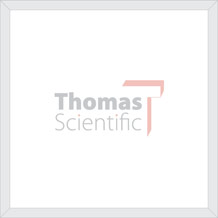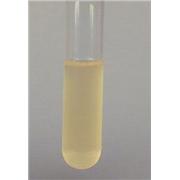bioWORLD, 500 g
-
Gellan Gum Powder
bioWORLDSynonym: Culturegel™ Type I: Biotech Grade Plant tissue culture tested Working Concentration: 1.5-2.5 g/L Gel Strength: 800 g/cm 2 Partially soluble in water
-
Boric acid (Molecular Biology Grade)
bioWORLDA commonly used molecular biology reagent and also used in electrophoresis buffers. pKa (@ 20°C): 9.24 Molecular Biology Grade (also available in Proteomics Grade) Chloride: <.001% Phosphate: <0.001% Sulfate: <0.01% Calcium: <0.005% Heavy metals…
-
Nutrient Agar, 500 g
bioWORLDRecommended for the cultivation of non-fastidious microorganisms according to the methods described by the American Public Health Association pH: 6.8 Working Concentration: 23 g/L Dehydrated Appearance: tan, homogeneous powder Prepared Appearance: light amber agar Soluble…
-
Potato Dextrose Agar, 500 g
bioWORLDUsed for the cultivation and enumeration of yeasts and molds especially Fusarium species To inhibit bacterial growth, the medium may be acidified to pH 3.5 by adding tartaric acid, lactic acid or some other organic acid The medium must not be heated after the addition of the acid, this…
-
bioPLUS™ Polyvinylpyrrolidone 40000
bioWORLDPolyvinylpyrrolidone 40,000, or better known as PVP, is a solubilizing polymer. It is an effective lubricant and protein stabilizer. PVP has been used to remove alkaloids and phenolics from plant tissue samples to improve mass spectrometry results. Polyvinylpyrrolidone is generally used at 2-4%…
-
Standard Methods Agar, 500 g
bioWORLDUsed for obtaining microbial plate counts from milk and dairy products, foods, water and other materials of sanitary importance Made according to the American Public Health Association (APHA) formulation pH: 7.0 Working Concentration: 23.5 g/L Dehydrated Appearance: light beige,…
-
bioPLUS™ Zinc Sulfate Heptahydrate
bioWORLDThe bioWORLD bioPlus™ zinc sulfate heptahydrate is mainly used in treatment of zinc deficiency. It is suitable for agricultural purposes. It is used in rayon producing industries. Zinc Sulfate Heptahydrate mainly acts as an anion channel blocker
-
Tryptic Soy Agar
bioWORLDUsed for the isolation and cultivation of nonfastidious and fastidious microorganisms Can be prepared with or without blood or enrichments pH: 7.3 Working Concentration: 40 g/L Dehydrated Appearance: light beige, homogeneous powder Prepared Appearance: Plain – light…
-
Guanidine thiocyanate
bioWORLDA useful tool in for RNA isolation and protein solubilization. A strong chaotopic agent used at high concentrations for denaturing native proteins and inactivating RNAses. Also known as Guanidine isothiocyanate Biotechnology Grade A280 (70%, water, 250°C): <0.8 …
-
bioPLUS™ Sodium Lauroyl Sarcosine
bioWORLDSodium Lauroyl Sarcosine is an ionic detergent reportedly an inhibitor of hexokinase. Sodium Lauroyl Sarcosine is used in concentrated salt solutions for cell lysis in RNA purification protocols and membrane solubilization. Application: For Research & Laboratory Use Only
-
Salmonella Shigella Agar, 500 g
bioWORLDHighly selective agar used for the isolation of Salmonella and some Shigella pH: 7.0 Dehydrated Appearance: tan, homogeneous powder Prepared Appearance: tan-orange to tan-red, clear to moderately hazy agar Soluble in boiling water Composition: Beef Extract …
-
Used for the selective enrichment of Salmonella sp. from meat products, feces, and sewage polluted water pH @ 25°C : 5.1 ±2°C Working Concentration: 26.6 g/L Dehydrated Appearance: Pale green to green, homogeneous powder Prepared Appearance: blue, clear broth …
-
Ammonium chloride
bioWORLDA compound used in the lysis of red blood cells and protein isolation techniques. It is a reagent used in a variety of industrial and research applications. Useful in protein isolation techniques. Also used in the study of basic calcium phosphate crystals in fibroblasts. Inhibits intracellular…
-
NZM Broth, 500 g
bioWORLDUsed for the cultivation of various genetic strains of E. coli Formulation recommended for replication of recombinant λ phage Does not contain Casamino Acids or Yeast Extract pH: 7.0 Dehydrated Appearance: light beige, homogeneous powder Prepared Appearance:…
-
Bacto Peptone (Powder)
bioWORLDUsed as an organic nitrogen source in microbiological media for culturing variety of bacteria and fungi Enzymatic digest of animal protein Working concentration: 50 mg/mL Dehydrated Appearance: faint yellow to yellow-brown powder Prepared Appearance: dark yellow solution …
-
BCYE Agar (Legionella Agar), 500 g
bioWORLDCommonly used in primary isolation of Legionella from environmental and clinical materials pH: 6.85 Dehydrated Appearance: dark grey to black, homogeneous powder Prepared Appearance: black-green to gray-black agar Soluble in boiling water Contains: (g/L: Yeast…
-
bioPLUS™ Sodium Chloride
bioWORLDSodium Chloride is arguably the most essential salt in molecular biology and cell culture. It is a common ingredient in cell culture media, lysis buffers, and protein storage. Molecular Biology Grade Sodium Chloride is of >99% purity and has been thoroughly tested for chemical impurities. It is…
-
Magnesium Sulfate, heptahydrate
bioWORLDA preparation of magnesium sulfate Synonym: Epsom salt ACS Grade Chloride: <0.0005% Nitrate: <0.002% Ammonium: <0.002% Calcium: <0.02% Heavy metals (as Pb): <0.0005% Iron: <0.0005% Manganese: <0.0005% Potassium: <0.005% …
-
Yeast Nitrogen Base,w/o Amino Acids
bioWORLDFor classifying yeasts based on amino acid and carbohydrates requirements Requires addition of a carbon source Does not contain histidine, methionine, or trypophan pH: 5.2 - 5.6 Working Concentration: 6.7 g/L (single-strength) or 67 g/L (10X) Can be supplemented with choice…
-
Yeast Nitrogen Base
bioWORLDFor classifying yeasts based on carbon assimilation Requires addition of a carbon source pH: 5.4 Working Concentration: 6.7 g/L (single-strength) or 67 g/L (10X) Dehydrated Appearance: off-white, homogeneous powder Prepared Appearance: single-strength solution is colorless…
-
Simmons Citrate Agar, 500 g
bioWORLDUsed as a differential medium for the identification of enteric bacteria, which utilize citrate as the sole source of carbon ph: 6.9 Working Concentration: 24.2 g/L Dehydrated Appearance: green, homogeneous powder Prepared Appearance: medium to dark green agar Soluble in…
-
Potassium ferricyanide
bioWORLDAn electron acceptor that is used to determine dopamine hydrochloride levels Reagent used in the buffer of B-Gal substrate assays. Specifications ACS Grade Insolubles: <0.005% Chloride: <0.01% Sulfate: <0.003% Ferric Compounds: <0.05% …
-
Cholesterol
bioWORLDA compound that is suitable for use in liposome preparation Ultra Pure Grade Moisture (LOD): <0.3% Appearance: White Crystalline Powder Boiling Point: 360°C(lit.) Density: 1.052 g/cm3 HS Code: 290613000 IUPAC_Name:…
-
Terrific Broth (TB)
bioWORLDHighly enriched medium developed to improve yield in plasmid-bearing E. coli Does not contain Glycerol pH: 7.2 Dehydrated Appearance: light beige, homogeneous powder Prepared Appearance: light to medium amber broth Soluble in water Contains: Bacto…
-
The bioWORLD bioPLUS™ anhydrous potassium phosphate dibasic is suitable for use in molecular biology experiments and plant tissue culture technique. Application: For Research & Laboratory Use Only
-
Ampicillin, trihydrate
bioWORLDSynonyms: D-(−)-α-Aminobenzylpenicillin salt A β-lactam antibiotic with an amino group side chain attached to the penicillin structure, 6-amino-penicillanic acid. A semi-synthetic penicillin derivative that inhibits bacterial cell-wall synthesis (peptidoglycan cross-linking)…
-
Ferric chloride, hexahydrate
bioWORLDA catalyst in organic synthesis ACS grade Insolubles: <0.01% Nitrate: <0.01% Phosphorus (as PO4: <0.01% Sulfate: <0.01% Copper: <0.003% Ferrous Iron: <0.002% Non-precipitables (NH4OH):<0.1% Zinc: <0.003 Regulated…
-
bioPLUS™ Sucrose, Ultra Pure Grade
bioWORLDSucrose is a disaccharide related to Glucose and Fructose. It is most commonly used in biotechnology as a carbohydrate source in plant tissue culture media. Sucrose has been observed to significantly improve root and shoot growth. Ultra Pure Grade Sucrose is DNase and RNase free. It is a popular…
-
Used for cultivating microorganisms from highly viscous or gelatinous materials pH: 7.2 Working Concentration: 25 g/L Dissolve in 960 mL purified water with 40 mL polysorbate 20 Dehydrated Appearance: beige, homogeneous powder Prepared Appearance: light amber broth …
-
Skim Milk Powder
bioWORLDUsed as a complete medium, or incorporated into other media, for isolation and cultivation of microorganisms found in milk products and to demonstrate coagulation and proteolysis of casein For Western Blots order product number which contains Sodium Azide to prevent bacterial growth
-
Agar medium used for the isolation and cultivation of dermatophytes and other pathogenic fungi from clinical specimens pH: 6.6 Dehydrated Appearance: homogeneous powder Prepared Appearance: light to dark, yellow to tan agar Soluble in boiling water Contains: …
-
Agar, Bacteriological
bioWORLDFine, light-colored granules Bacteriological Grade Gel Strength: 550–950 g/cm2 Gelling Temperature: 34–38 °C Melting Temperature: 84–88 °C pH: 6.0–7.5 Soluble in boiling water






























